The River Advocate
March 25, 2016
Vol6 #2
In this issue:
River Advocacy Training School – Apply By April 1
California Rivers Day – Visit Your Legislator
New Dam proposed for the Bear River
Just The Facts…FOR coordinates a storage response.
Intern with Friends of the River
River Currents
California River Calendar: Events & Activities
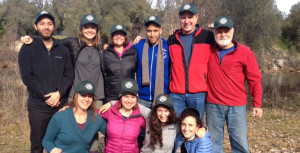 Learn how to make a paddle more powerful for people and policy!
Learn how to make a paddle more powerful for people and policy!
The FOR River Advocacy Training School leads the way. Gain hands-on experience in community organizing and policy advocacy “FOR” the river! Rafting and canoe training included. Apply by April 1st RATS.Application.Summer 2016.
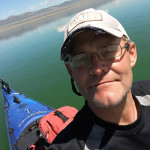 Visit Your Legislator on May 18 – Be the Voice of Your River!
Visit Your Legislator on May 18 – Be the Voice of Your River!
Johnnie Carlson, California Rivers Day Coordinator
On May 18 over two dozen river groups and businesses along with individuals just like you will descend on the state capitol in Sacramento to make our voices heard and our rivers known for California River Day at the capitol! This fun, exciting, and empowering day will bring river advocates and citizen activists from all across California together to celebrate our rivers and to continue building a powerful river protection movement.
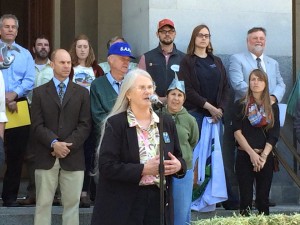 FOR will be scheduling legislator visits for participants with Assembly and Senate leadership and key committee members, as well as with legislators representing our threatened rivers and river organizations present from 10:00 am to 5:00 pm that day. Participants will travel and visit legislators in teams and each will be set up to include experts, advocates, employers, and citizens from each member’s district. In addition to discussing pending legislation, we will be presenting legislators with a set of positive proactive solutions to increase California’s water supply though conservation, water recycling, and more. Lastly we will be inviting legislators and their staff to come join us on river and get to know more about these treasures of California.
FOR will be scheduling legislator visits for participants with Assembly and Senate leadership and key committee members, as well as with legislators representing our threatened rivers and river organizations present from 10:00 am to 5:00 pm that day. Participants will travel and visit legislators in teams and each will be set up to include experts, advocates, employers, and citizens from each member’s district. In addition to discussing pending legislation, we will be presenting legislators with a set of positive proactive solutions to increase California’s water supply though conservation, water recycling, and more. Lastly we will be inviting legislators and their staff to come join us on river and get to know more about these treasures of California.
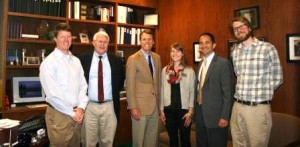 Even if you have never lobbied or visited a legislator, FOR has you covered – we will hold pre-event training calls on legislative visits and river issues. Additionally, we will have Participants start the day at our Legislative Breakfast to get presentations on the key issues and do practice sessions in the same teams you will be meeting legislators with later in the day. Most groups will have between 3 and 4 visits pre-scheduled and do 1 or 2 drop in visits. We can accommodate folks who can make all or just part of the day. If you would like to attend please sign up today!
Even if you have never lobbied or visited a legislator, FOR has you covered – we will hold pre-event training calls on legislative visits and river issues. Additionally, we will have Participants start the day at our Legislative Breakfast to get presentations on the key issues and do practice sessions in the same teams you will be meeting legislators with later in the day. Most groups will have between 3 and 4 visits pre-scheduled and do 1 or 2 drop in visits. We can accommodate folks who can make all or just part of the day. If you would like to attend please sign up today!
If you are with an organization or business – you can build your own teams and FOR can help plan, request, and coordinate your visits. For more information about how your business or organization can attend and participate please email us at jcarlson@friendsoftheriver.org or call (916) 442-3155 ext 211.
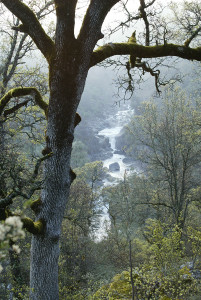 New Dam Proposed on Bear River
New Dam Proposed on Bear River
Otis Wollan, American River Watershed Institute – Special to the River Advocate
New dam proposals are proliferating around the state as a result of Proposition 1, the 2014 “drought initiative” that appropriated $2.7 billion for new storage. The newly proposed Centennial Dam on the Bear River near Auburn is a prime example. In a bizarre twist, this dam, first proposed in 1926, is being championed as a “climate change solution.” The proposed dam would inundate one of the last remaining natural seven mile reaches of the Bear. The first public comment period of the Environmental Impact Statement process is open until April 18 (see below).
The project was first proposed nearly a century ago as a “debris dam” when State money was made available to dam building for the purpose of stopping the silt from hydraulic mining from flowing into the Bay Delta system. It was the era that produced dams like Englebright Dam on the Yuba River, and Clementine Dam on the American River. At that time, the project was called Parker Dam by the Nevada Irrigation District (NID, located in Grass Valley/Nevada City). At that time, the project was rejected for funding.
Again in the 1950’s dam-building flurry, the Parker Dam was considered as a water and power supply project. NID built Rollins Dam further upstream, and rejected the Parker Dam again.
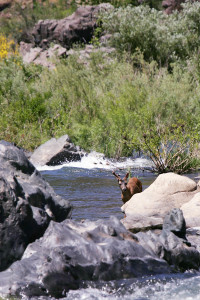 Today, the Parker Dam is re-branded as Centennial Dam, and is being touted as the first in a new wave of “environmental dams” built to protect California from the threat of climate change, “enhance the area’s environmental and recreation needs,” and promote “sustainable agriculture” (from NID’s website http://www.centennialreservoir.org/). In fact, the project completely misses the mark relative to climate change, would destroy one of the richest oak woodland habitats in the mid-Sierra, inundate CA Department of Fish and Wildlife lands that are protected as the Placer County’s Bear River Campground as well as BLM lands and Pacific Lands Stewardship Council lands now protected by the Placer Land Trust, threaten the American Sub-basin groundwater supply, and destroy a popular Class II kayak run.
Today, the Parker Dam is re-branded as Centennial Dam, and is being touted as the first in a new wave of “environmental dams” built to protect California from the threat of climate change, “enhance the area’s environmental and recreation needs,” and promote “sustainable agriculture” (from NID’s website http://www.centennialreservoir.org/). In fact, the project completely misses the mark relative to climate change, would destroy one of the richest oak woodland habitats in the mid-Sierra, inundate CA Department of Fish and Wildlife lands that are protected as the Placer County’s Bear River Campground as well as BLM lands and Pacific Lands Stewardship Council lands now protected by the Placer Land Trust, threaten the American Sub-basin groundwater supply, and destroy a popular Class II kayak run.
To join with Foothills Water Network in opposing this project, go to www.SaveBearRiver.com to learn more and take action now.
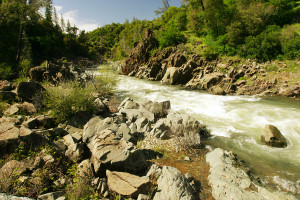 Save Bear River events
Save Bear River events
Become a friend of the Bear River! Several upcoming events will connect you with the river, and with the community of groups and individuals that are working to save the Bear River.
Day hikes, tours and a “mini-environmental fair” are scheduled for Saturday April 2 and Sunday April 3 at the Bear River Campground near Colfax. See www.SaveBearRiver.com Family camping is also available, with no fee, on April 2-3.
Comment letter orientation meetings for the first public EIS process on Centennial Dam are being held April 10 and April 12 in Nevada City, April 11 in Colfax, and April 13 in Auburn. See “action steps” at www.SaveBearRiver.com
Put some skin in the game. Become engaged in the process by writing a comment letter as the first step in the Centennial Dam Environmental Impact Statement. Comment period ends April 18, 2016. Attend an event or meeting above, or get the letter writing guide and issue overview at: http://yubariver.org/issues/nids-centennial-dam-proposal-for-the-bear-river, or
www.SaveBearRiver.com
Just The Facts…FOR coordinates a storage response
Johnnie Carlson, Operations Director
With a multitude of proposals for new or expanded dams in California and the need to prioritize the most sustainable and efficient alternatives, Friends of the River is joining together with participants from 20 river and river related organizations and getting to work. Starting in November of 2015 with an in-person brainstorming and strategy session, the goal of the group is to investigate the facts behind each project and develop unified responses where we can come together. There are 7 new storage projects currently on the table (north-to-south: Shasta Dam raise (Sacramento & McCloud Rivers), Sites dam in Antelope Valley (off-stream & Sacramento River), Centennial dam (Bear River), San Luis Dam raise (off-stream), Los Vaqueros Dam raise (off-stream), New Exchequer Dam raise (Merced National Wild & Scenic River), and Temperance Flat dam (San Joaquin River Gorge).
In addition to a dozen or so local citizen river advocates, the group consist of policy representatives of 20 organizations so far including: The Sierra Club, The Bay Institute, American Whitewater, American Rivers, Sacramento River Preservation Trust, Clean Water Action, Trout Unlimited, Cal Trout, Winnemem Wintu Nation, Big Sandy Rancheria Nation, Defenders of Wildlife, Planning & Conservation League, The Nature Conservancy, Natural Resources Defense Council, the River Exchange, Butte Environmental Council, Hydropower Reform Coalition, and the San Joaquin River Parkway & Conservation Trust, The San Joaquin Valley Leadership Forum, and Friends of the River.
The group is developing revised project fact sheets for the proposed new or expanded dams as well as menu of alternatives for our state’s leaders that can put us on the right path to sustainable water for all Californians. The group has held its first legislative briefing (March 4th) for about 20 capitol staffers, will be a part of FOR’s organizing for California Rivers Day, and is planning outings to the impacted rivers for media, politicians, and local citizens. If you or your organization is interested in learning more about the group please email or call us at: jcarlson@friendsoftheriver.org or 9916) 442-3155 ext 211.
 Internship & Volunteer Positions at Friends of the River
Internship & Volunteer Positions at Friends of the River
FOR has policy, outreach, office, and river internships, and volunteer positions open year round. FOR is active in river and water policy and drought issues statewide and has one of the few in-house legal teams in the nonprofit community. We run an active outreach and river rafting program as well as maintain our primary office in midtown Sacramento. We are actively seeking a communications/social media intern as well as a video/social media intern to help build our website, YouTube channel, and help us get the word out about the rivers of California.
To apply or for more details on positions and opportunities currently open feel free to give us a call or email us at the contact information below.
Friends of the River is widely recognized as an authority on the impacts of dams, industrial and agricultural operations and land use policy on rivers and riparian habitat. FOR was founded in 1973 during the struggle to save the Stanislaus River from being destroyed by the construction of New Melones Dam. FOR went on to become California’s only statewide river conservation group, dedicated to preserving, protecting, and restoring California’s rivers and their watersheds. Today, FOR has five full-time staff, a cadre of 100 plus volunteers, and a robust membership.
FOR has a long list of accomplishments that includes permanently protecting more than 2,100 river miles as Wild & Scenic rivers, repeatedly defeating federal legislation to build Auburn dam on the American River, and convincing Congress to authorize an environmentally protective flood control project for Sacramento in 2003. FOR achieves these goals through public outreach, grassroots organizing, and expert advocacy to influence public policy. FOR also supports vibrant volunteer rafting and canoeing programs that connect hundreds of people to rivers, and introduces inner city youth to boating.
Questions: Email info@friendsoftheriver.org or call us at (916) 442-3155 ext. 211
To Apply: Send cover letter, resume, and 2-3 page writing sample to info@friendsoftheriver.org or fax to (916) 442-3396. FOR is an Equal Opportunity Employer.
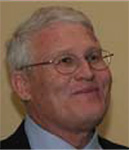 River Currents
River Currents
Ron Stork, Policy Director
The Deadbeat Dam Report
Friends of the River is working to manage a small handful of large deadbeat dams that hope to be supplicants for the California Water Bond (Proposition 1) $2.7 billion in funding to be doled out by the California Water Commission. It’s good to have a status report from time to time. So here we go.
California Water Commission
The California Water Commission has promulgated some draft regulations on how it intends to select projects to receive the Water Bond taxpayer subsidies. The regulations are called Water Storage Investment Program Quantification Regulations, which is quite a mouthful.
The regulations have to implement the Water Bond, so they’re not very pretty. Basically, supplicants develop a rationale that the dam is being built, in whole or in part, to achieve public benefits (recreation, flood control, emergency response, and ecosystem and water quality improvements). The Commission then screens and reviews their application, gets an independent panel to do the same, ranks them, awards money to apply for permits (up to 10% of the capital cost of the project), conditionally awards them construction money, then gives them the money when they have their environmental impact report done, their permits in hand, and the will and the finances to build the dam.
No more than 50% of a project can be funded with Water Bond money (except for dam reoperation projects — no limit there) but at least 50% of the public benefit has to go for ecosystem restoration, the latter being pretty easy to cook up now that dams aren’t being built for water anymore (so they say), Yes, the traditional beneficiaries aren’t going to pay the costs for so little new water, so they’ve got to come up with something.
Before money is awarded, the public will have the opportunity to tell the Commission that the supplicant is just making up a story that the project has significant public benefits. Whether they will believe us when they have $2.7 billion burning a hole in their pockets, I don’t know. But we and you should make the effort.
Our comments on these regulations are posted here and should be soon on their website.
More on the process can be found here: https://cwc.ca.gov/Pages/QuantificationRulemaking.aspx
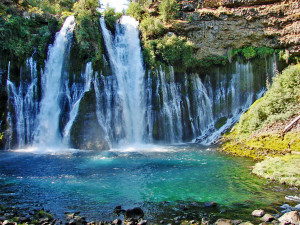 Shasta Dam raise
Shasta Dam raise
Outside of the Westlands Water District and Metropolitan Water District of Southern California Board rooms, this project just gets no respect.
It’s illegal under state law for the state or the districts to participate in this project. The Water Bond and its regulations don’t allow Water Bond funding for it. In fact, it’s illegal under current federal Reclamation law because it’s illegal under state law. And there’s some Native Americans who aren’t too happy about the proposed raise either.
That said, the previously mentioned Districts do have juice in the legislature and the Congress — and laws can be changed. But for now there is no organized state sponsor for this project.
But the project does have a final federal environmental impact statement (EIS) (although with no recommended alternative), and the Feinstein “drought” bill (S.2533) does purport to let the Secretary of the Interior “authorize” the project on her own, although the project has to be lawful. Alas, Lord knows what the bill will say if it is conferenced with the House of Representatives.
Friends of the River has prepared a twelve-page detailed memo on why the Department of the Interior finds itself stymied to pull off this project. It’s an interesting read, providing some detail into why this is just another deadbeat dam, unworthy of the $1.3 billion that might get spent on it.
You might want to share it. Our fact sheet too.
SLWRI unresolved issues memo – Feb 24 2016
Shasta Dam Raise Fact Sheet 3-2-2016
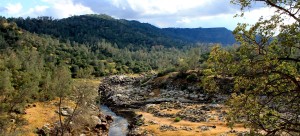 Temperance Flat Dam
Temperance Flat Dam
This proposed 655 ft. tall. concrete monolith damming the San Joaquin River gorge has lots of salesmen in the Fresno era who believe their own con job.
They have formed a joint powers authority, the San Joaquin Water Infrastructure Authority, to receive a billion or two to finance half of it, along with a huge helping hand from the federal government. (Incidentally, it would be great to have a volunteer watch their board meetings the second Friday of the month at 9:00 a.m. at 2907 Maple Ave in Fresno). Of course everyone who is anyone in the Fresno area appears to have taken a loyalty oath to be a project booster.
It’s no surprise that Senator Feinstein is also a project booster. Her “Drought” bill authorizes the Secretary of the Interior to begin with construction if it passes her review.
This dam does not have a completed federal EIS, although one is “scheduled” to be completed this month, so we don’t have quite the same lovely memo on the problems with this dam, at least using the Department of the Interior as our source.
But the proposed dam does have its problems. Here’s a few.
1) There are no water rights left on this river; well, the dams and canals already have demonstrated their ability to keep this river downstream dry as a bone year in and year out. And you can’t legally build and operate this project without water rights. Well, unless you break the law and take water from someone else or other purpose.
2) To generate enough revenue to make the project slightly above laughable, the project sponsor, the U.S. Bureau of Reclamation, offered to sell the water to the highest bidder, which usually means folks south of the Tehachapis. The good folks around Fresno will not get this water, water that now flows to farms and cities along the east side of the southern San Joaquin Valley.
3) To get money to pay for public benefits from the Water Bond, you’re supposed to have some public benefits. Some are going to be pretty hard to justify, although Reclamation has worked hard to spin some stories. But, mostly, no matter how you slice it, the good folks around Fresno don’t get this water either.
4) The dam will make a lot of water that now flows into the fields and sinks into the sand around Fresno much more expensive. It’s not clear that farmers around there will buy expensive water. See what I mean about believing their own con job?
5) The San Joaquin River gorge is a pretty nice place now (see it this Spring!), and the Bureau of Land Management has a completed EIS and Record of Decision recommending that it be made a national wild and scenic river. Secretary of the Interior Jewel needs to take note of that.
So for now, the fate of the dam is in the hands of the politicians to figure out ways to create a fantasy world in which the dam could thrive. Maybe they can, maybe they can’t. But the real world can be hard to ignore sometimes. Oh, and maybe the river’s friends can help with that.
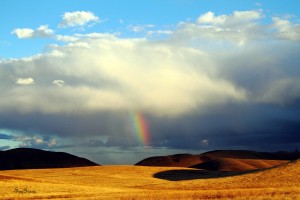 Sites Dam and Reservoir
Sites Dam and Reservoir
This is a large offstream reservoir that would be supplied with canal diversions from the Sacramento River.
It’s kind of pricey, the L.A. Times quoted federal sources that the latest cost estimate was $6.3 billion dollars, $2.5 billion more than a previous estimate, but it isn’t obviously illegal to build and operate, at least at this time. Faint praise, of course.
It’s also the California Department of Water Resources’ (DWR) favorite dam project, and DWR seems interested in moving it forward. They’ve mostly been waiting for the local farming districts to form a joint powers authority (which they’ve done) to help to fund (which they hope to do) a draft environmental impact report for the project, which DWR has already mostly completed (at least in DWR’s view).
Without a stable project description, the project is in the sales phase of existence, where its boosters can claim almost any project accomplishment — and do. The dam boosters job is to sell the project so well that when the real accomplishments become evident, it will be too late for buyer’s remorse. It could be a winning strategy.
It’s hard to pierce the many veils surrounding this project, but it has been rumored that its principal intended customer (with all due deference to the locals), the Metropolitan Water District of Southern California, wants to hold off on this project for now until they know if they can build the tunnels under the Delta to move this water safely and securely (from their perspective) under DWR’s and the Kern Water Bank’s supervision to the state’s southland. They hope to know whether the tunnels will be permitted (and financeable) by the end of this year.
Sites Fact Sheet FOR 8_8_13 2015 rev2
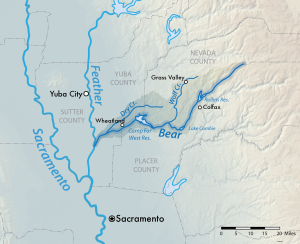 Centennial Dam
Centennial Dam
Although Sites dam, if built with a 43% contribution from the California Water Bond, would suck up the entire bond, the Bond has attracted small $300 million dollar dam projects too.
The Nevada Irrigation District (NID) is moving quickly to complete an environmental impact on a mere 240 ft. tall dam on the Bear River (that’s the river between the American and the Yuba). See an announcement elsewhere about going to a scoping meeting.
NID is maneuvering to get a relatively superior water right, the Congress to transfer the federal land around the project to them, and a Corps of Engineers streambed alternation (I’ll say!) permit for now — and later adding a hydroelectric project with an exemption from the Federal Energy Regulatory Commission’s licensing process available for already existing canals and conduits (Pretty sly, eh?).
They couldn’t pull this one off without some big financial subsidies from the Water Bond, as well as finding some wealthier customers to sell their water too. A lot of folks are watching this to see if NID can pull this one off. And there’s some folks who are not just watching. As I’ve said many times before, democracy should not be just a spectator sport.
 California River Calendar: You Otter Go To Some River Events & Activities!
California River Calendar: You Otter Go To Some River Events & Activities!
Got an item for the California River Calendar – email us: info@friendsoftheriver.org Keep it short and include the city, date, and a link to learn more or sign up.
Colfax: Saturday April 2 & Sunday April 3
Foothills Water Network – Become a Friend of the Bear
Become a friend of the Bear River! Several upcoming events will connect you with the river, and with the community of groups and individuals that are working to save the Bear River. Day hikes, tours and a “mini-environmental fair” are scheduled for Saturday April 2 and Sunday April 3 at the Bear River Campground near Colfax. See www.SaveBearRiver.com Family camping is also available, with no fee, on April 2-3.
Sacramento: Saturday April 9
American River Parkway Foundation’s Spring Clean-Up
Join the ARPF at one of 8 clean-up sites along the Lower American River. For more information visit www.arpf.org
Sacramento Valley: Saturday April 16
River to Valley: A tour of the impacts of the proposed Sites reservoir near Colusa
Join FOR and the Sacramento River Preservation Trust for a single-day land tour of the proposed intakes sites on the Sacramento River and reservoir site that would drown the Antelope Valley – one of the few remaining examples of intact California prairie. To get details or RSVP please visit the registration page.
Grass Valley: Thursday April 21
SYRCL’s State of the Yuba
SYRCL has scheduled its 3rd annual “State of the Yuba” on April 21 to report to the citizens of the Yuba watershed the condition of the river, outline SYRCL’s priorities for the coming year, and most importantly, enlist all river lovers in the protection and restoration of the Yuba. This FREE event is for all members of the community who care about the Yuba River and want to know more about SYRCL’s efforts to protect the watershed. Bring your appetite and a reusable pint or glass, because we will have wine, Three Forks Bakery & Brewing Co. beer and tacos from Fatbelly Taqueria available for purchase.
Doors will open at 5:00 pm for an open-house format with time for you to speak with SYRCL staff and two of SYRCL’s partners, the Foothill Water Network and The Sierra Fund. The program will begin promptly at 6:00 pm. More information at: http://yubariver.org/annual-events/state-of-the-yuba/
Los Angeles: Saturday April 16, Saturday April 23, and Saturday April 30
Friends of the Los Angeles River’s Great Los Angeles River Clean-Up!
The Great Los Angeles River Clean-Up is the nation’s largest urban river Clean-Up drawing thousands of volunteers to fifteen sites over three weekends in April. This Earth Month do your part – go to http://folar.org/cleanup and sign up!
Fresno-Aubrey: Saturday April 30 and Sunday May 1
San Joaquin River Gorge Camping & Hiking Outing
Join Friends of the River as well as local river activists and residents to tour the magnificent San Joaquin Gorge. The section of the San Joaquin has been recommend for National Wild & Scenic status and is home to rare water-carved granite caves, Class IV kayaking runs, world-class horseback trails, and spectacular vistas. To get details or RSVP please email: info@friendsoftheriver.org.
Sacramento: Wednesday May 18
California Rivers Day at the capitol
Join FOR and dozens of other rivers groups and be the voice of your river! Tables and booths representing rivers across the state and a noon program. Learn More at: www.friendsoftheriver.org/our-work/california-rivers-day Sign up to visit your legislator at:
Sacramento: Wednesday May 18
Capital River Awards
Friends of the River (FOR) is pleased to announce the Capital River Awards to celebrate our treasured rivers and promote their protection. This festive event is a great chance to re-connect with old friends and make some new ones over great food and wine just steps from the Capitol. The party will follow FOR’s California Rivers Day at the Capitol—a day of education, outreach, and activism promoting rivers and water conservation. To learn more visit: http://www.friendsoftheriver.org/support-for/capital-river-awards/
Coloma: Friday May 20 (first day of class)
River Advocate Training School (applications due April 1st)
The River Advocacy Training School (RATS) trains people to engage their community in issues that impact California’s rivers. The summer/fall cohort focuses on supporting the river programs during the summer and organizing an event in their community in the fall.
What is different about this cohort is that they start with either Basic Whitewater Guide Training or Flatwater to moving water canoe training and then use those skills to be a voice for California’s rivers on trips and outings. The program culminates by early November. To learn more visit: http://www.friendsoftheriver.org/get-involved/river-rats
THE RIVER ADVOCATE IS PUBLISHED BY FRIENDS OF THE RIVER.
QUESTIONS OR COMMENTS – PLEASE EMAIL US AT:
INFO@FRIENDSOFTHERIVER.ORG.

